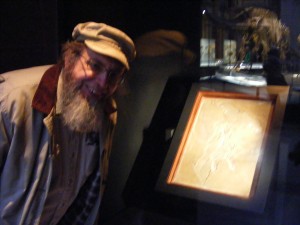In my last blog, submitted only a day ago, I said that there were three things that have long been on my list of places to visit in Poland. I am on my way to the third of these this weekend. But as always, there is a backstory.
Von Paul Schulz was a high school science teacher in what was then the independent half German-half Polish free city of Danzig, in between the wars. He was also a scientist. There are some who would call him an amateur, since he was not employed as a scientist, but in my book anyone who does good science and publishes the results to add more to our common knowledge of nature is by definition a scientist. Schulz, like Gregor Mendel fifty years before him, was one who was driven by curiosity to learn new things. Schulz studied diatoms, and published maybe a half-dozen articles in the scientific journals.
He also developed an interest in silicoflagellates. Schulz acquired diatomites from many of the known deposits of the time, from California, New Zealand, Denmark, Russia, the Caribbean, Japan – all over. And in 1928 he published a very substantial – arguably the first substantial – article on silicoflagellates. Schulz was also a very responsible scientist. He had great knowledge that he had worked hard to get and he could have described new species willy-nilly, as many amateurs – including some employed as scientists – have done, but he restrained himself. He knew that this field was in its infancy and that describing too much too soon would only muddy the waters, and so he worked within the established taxonomy. At that time to his knowledge there were only two silicoflagellate genera. But Schulz did find something that was truly new and unusual, and he had the knowledge to know that it was unusual, so he described the new genus Cornua, which he illustrated with three simple line drawings.
Many other silicoflagellate genera have been described since then, including three genera that were described by another scientist in 1928, in each of which there are now many species. Much was learned about silicoflagellates in general, except Cornua. The genus was also observed in the Urals of Russia in the 1950s and a second species was described, also illustrated by simple line drawings, but otherwise Cornua was, to use another person’s phrase, a mystery wrapped in an enigma.
I came into silicoflagellates in 1982. I was interested in the simple geometries and found the field to be wide open. I could make contributions to science here, and dedicated my life to that goal. Even before I finished graduate school I was the one being asked to write the silicoflagellate chapters for short course notes and text books. I reviewed the silicoflagellate literature and the work of the people who contributed to it. I learned a great deal about everything related to silicoflagellates, except Cornua. I myself wondered if they might just be freak specimens. Four years ago my friend and colleague Dave Harwood sent me a picture of Cornua that a graduate student of his had found in sediments from the Arctic. A genuine photograph of the beast! This is what launched me on the research that has taken to Poland.
The place on my list of things to do is the site where Cornua was originally found. The specimens that Schulz observed came from within the bodies of preserved Cretaceous sponges that were later deposited in glacial till along the southern shore of the Baltic, near what is now called Gdansk, in what is now Poland. Schulz correctly determined the age of these fossils, not an easy thing to do of something unknown and found in a glacial till, as from the middle of the Late Cretaceous. They were the oldest known silicoflagellates until Dave Harwood and myself found older ones, from the Early Cretaceous, sixty years later.
We leave today to go to those shoreline deposits to see if we might find fossil sponges of our own and rediscover the flora that Schulz saw. In another couple of weeks we plan to go to Germany to see what may be the microscope slides that Schulz used.
I myself have always been interested in history, in both the rock and human records, and I hope with the help of colleagues here to learn enough of Paul Schulz to perhaps write something about the man himself, in addition to the silicoflagellates and diatoms that he observed. I have always had a weak spot in my heart for the people who were driven to do good science on their own time and money. Von Paul Schulz deserves to be remembered.

